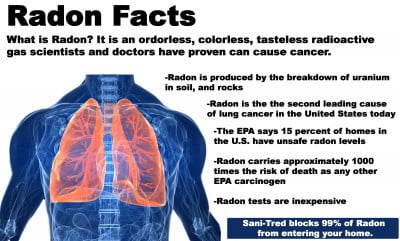Most harmful chemicals and gases in your home are easily detected by the odor or fumes they leave behind. However, radon is  one of those gases, which is hard to detect, because you cannot see it. To detect the presence of radon in your home, you need to perform a simple test, which only takes a few minutes to complete.
one of those gases, which is hard to detect, because you cannot see it. To detect the presence of radon in your home, you need to perform a simple test, which only takes a few minutes to complete.
Do- it- yourself radon test kits are available from several sources; hardware stores, through the mail, or from certain retailers. However, if you suspect radon in your home, you can contact a qualified tester, or contact a private radon program provider in your area. There are two types of testing you can perform:
Short- Term Testing
The easiest and quickest way test for radon is to perform short- term tests. Short- term testing requires the use of one of five methods, which lasts from two to 90 days; “electret ion chamber”, continuous monitoring”, “charcoal liquid scintillation”, “charcoal canisters”, and alpha track.” Detectors provide the best solution for short- term testing, because radon levels vary, from season one season to the next season, and from day to day.
However, short- term testing does not disclose the year round levels of radon that is present. Long- term testing is the best testing method, if you want to acquire an accurate reading of radon levels; otherwise, you will need to perform an additional second short- term test.
Long- Term Testing
Long- term testing, which is performed by either an alpha track or electret detectors, tests the home for more than three months. The long – term testing will provide you with a more accurate measure of radon levels, than a short- term test.
Presence of Radon in the Home
Radon is present in one of several ways; in the soil and water supply, or through indoor air. Radon entering the home through soil poses a greater risk than radon that enters the home through the water supply. Radon found in the air can increase the risk of lung cancer, and stomach cancer.
Radon found in the water supply is likely to create some problems when it is swallowed, although, breathing in radon is much more dangerous. The greatest danger from radon comes when radon is released into the air, doing showering, or when performing household cleaning, that requires the use of water.
Directions on How to Use a Radon Test Kit
Before starting a short- term test, be sure to close all the windows, and let them remain closed during the test. Be sure to keep the heating and air conditioning running, so that the air can circulate throughout the home. Do not operate machinery and fans, which brings outside air into the home.
However, cooling equipment which is a part of the radon testing process should be in full operation. If you are performing a short- term test, which normally lasts 2 to 3 days, be sure that the doors and windows leading to outside, have been closed for at least 12, before you began the test.
The radon test kit should be put in an area of the home, which is less likely lived in, such as the basement, or on the first floor. The kit can be placed in a bedroom, playroom, or living room, but never in the kitchen. It should be placed 20 inches above floor level, so the testing is not interrupted by heat, moist or air.
Leave the kit in place for the correct amount of time specified on the test. After the testing is completed, seal it, and mail to the testing lab indicated on the test, and wait for the results, which should arrive within two weeks.
Learn more about Radon from our Radon Health Facts Infographic and the EPA Radon Facts.
The Sani-Tred Solution
Radon is a harmful colorless, odorless, tasteless radioactive gas that is present in homes worldwide and is responsible for 21,000 cancer deaths in the US annually. Watch this 1 minute explaining how the University of Wisconsin lab tested Sani-Tred and found it effective at blocking 99% of Radon from entering homes in addition to it’s permanent waterproofing effects. Call 1-866-784-3308 or visit https://sanitred.com/radon-gas-elimination/ to learn more.
